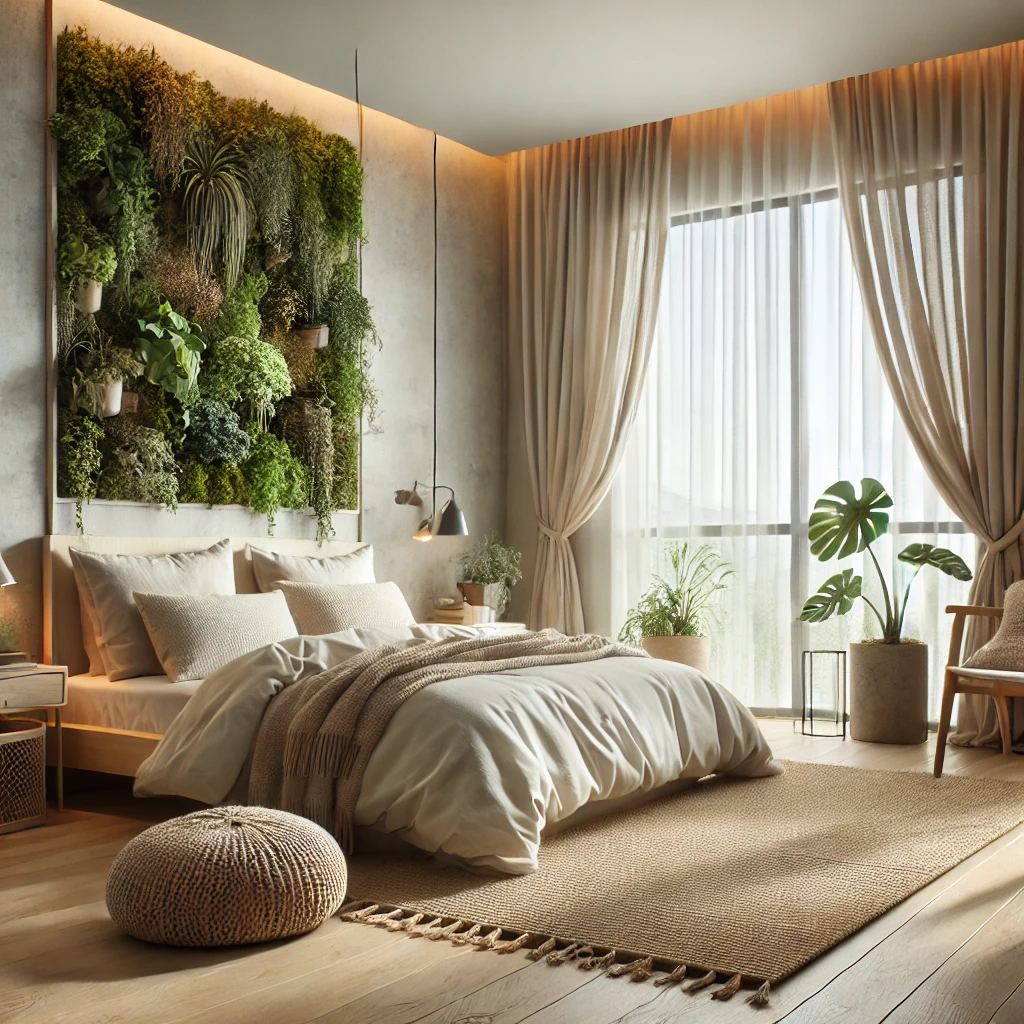In 2025, green interior design will become increasingly popular as it combines sustainability with contemporary style. This guide will assist you in exploring the newest green interior design trends if you want to create a house that is both environmentally friendly and in harmony with the natural world. Learn how to make your living area both fashionable and ecologically conscious by utilising sustainable materials and energy-saving techniques.
1. Eco-Friendly Materials for a Sustainable Home
The cornerstone of green interior design is the use of sustainable materials. You can choose eco-friendly substitutes that will not only lessen your home’s impact on the environment but also give it a more organic feel.
- Bamboo Flooring and Furniture: A durable and renewable resource that gives your space a warm, organic feel.
- Reclaimed Wood: Adds character and history to your home while reducing deforestation.
- Cork: A natural, sustainable material perfect for flooring and wall paneling.
- Recycled Glass Countertops: Stylish, durable, and made from post-consumer glass waste.
- Organic Fabrics: Choose natural fibers like linen, hemp, or organic cotton for upholstery, curtains, and rugs.
2. Biophilic Design: Bring Nature Indoors
Biophilic design focuses on integrating natural elements into your interiors, improving air quality and boosting well-being.
- Indoor Plants: From snake plants to fiddle leaf figs, greenery purifies the air and enhances your space.
- Living Walls: Vertical gardens create a stunning focal point and help regulate indoor temperatures.
- Natural Light Maximization: Large windows, skylights, and glass doors reduce the need for artificial lighting.
- Water Features: Indoor fountains and small water walls promote relaxation and add a calming effect.

3. Energy-Efficient Lighting and Smart Technology
Sustainable interior design in 2025 is all about energy efficiency. LED lighting and smart home systems play a crucial role in reducing your carbon footprint.
- LED Bulbs: Use 75% less energy and last longer than traditional bulbs.
- Motion-Sensor Lighting: Automatically turns off when not in use, saving electricity.
- Smart Thermostats: Adjust room temperature based on occupancy, reducing energy waste.
- Solar-Powered Lights: A great option for both indoor and outdoor spaces.
4. Sustainable Paint and Finishes
Many conventional paints release toxic chemicals known as VOCs (volatile organic compounds). Choosing eco-friendly alternatives enhances indoor air quality.
- Low-VOC or Zero-VOC Paints: Safer for your health and the environment.
- Natural Clay or Lime-Based Paints: Offer a rustic, earthy aesthetic.
- Beeswax or Plant-Based Wood Finishes: Protect wood surfaces without harmful chemicals.
5. Minimalist and Sustainable Furniture Choices
Green interior design embraces minimalism, reducing excess consumption and promoting mindful purchasing.
- Modular Furniture: Adaptable, multi-functional pieces reduce waste.
- Vintage and Upcycled Furniture: Gives a second life to pre-loved items, reducing landfill waste.
- Sustainable Upholstery: Opt for recycled polyester, organic cotton, or plant-based leathers.
6. Water Conservation Strategies
Sustainable interior design goes beyond materials and decor—it also involves water conservation.
- Low-Flow Faucets and Showerheads: Reduce water consumption without compromising performance.
- Rainwater Collection Systems: Ideal for watering indoor plants.
- Water-Efficient Toilets: Dual-flush models help cut down on water usage.

7. Eco-Friendly Home Accessories and Decor
The details matter when it comes to sustainable living. Opt for home accessories that align with your eco-conscious values.
- Handmade and Locally Sourced Decor: Supports artisans and reduces carbon footprint.
- Natural Fiber Rugs: Jute, wool, and hemp rugs are biodegradable and stylish.
- Recycled Metal or Glass Accents: Sustainable choices for vases, lighting fixtures, and frames.
- Soy or Beeswax Candles: A healthier alternative to paraffin-based candles.
8. Sustainable Kitchens and Bathrooms
Your kitchen and bathroom are prime areas to incorporate green design principles.
- Eco-Friendly Countertops: Recycled glass, bamboo, or sustainable quartz.
- Compost Systems: Reduce food waste efficiently.
- Plastic-Free Storage Solutions: Glass jars, bamboo containers, and stainless steel alternatives.
- Water-Efficient Dishwashers and Washing Machines: Save energy and reduce water waste.
9. Smart Flooring Solutions
Choosing sustainable flooring options reduces environmental impact and promotes a healthier indoor environment.
- Recycled Carpet Tiles: Made from repurposed materials and easy to replace.
- Linoleum Flooring: 100% biodegradable and a great alternative to vinyl.
- Stone and Clay Tiles: Durable, non-toxic, and naturally insulating.
10. Eco-Conscious Workspaces and Home Offices
With remote work becoming more common, sustainable home offices are gaining popularity.
- Reclaimed Wood Desks: Sustainable and stylish.
- Ergonomic, Sustainable Office Chairs: Made from recycled or upcycled materials.
- Energy-Efficient Monitors and Laptops: Reduce electricity consumption.
- Houseplants for Air Purification: Keep your workspace fresh and vibrant.
Final Thoughts
Creating a home that expresses your beliefs while lessening your environmental effect is the goal of green interior design in 2025. Every step contributes towards a greener future, whether you start small by increasing the number of indoor plants or go big with sustainable renovations. You can enjoy a lovely and cosy house while meaningfully contributing to a healthier planet by selecting eco-friendly materials, adopting energy-efficient solutions, and cutting trash.
Transform your living space with these sustainable interior design ideas and make 2025 the year of green living!
